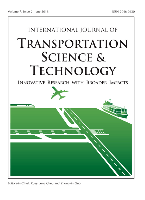
International Journal of Transportation Science and Technology
Scope & Guideline
Connecting research with real-world transportation challenges.
Introduction
Aims and Scopes
- Traffic Modeling and Simulation:
Research aimed at developing models to simulate and analyze traffic flow, vehicle interactions, and the impact of various traffic management strategies. - Sustainability and Environmental Impact:
Studies that assess the environmental implications of transportation systems, including carbon emissions, material usage, and sustainable practices in infrastructure development. - Safety and Risk Analysis:
Investigations into factors affecting transportation safety, including accident analysis, risk assessment methods, and the impact of human behavior on road safety. - Technological Innovations in Transportation:
Exploration of emerging technologies such as machine learning, artificial intelligence, and smart infrastructure to enhance transportation efficiency and safety. - Public Transit Systems and Accessibility:
Research focused on improving public transportation systems, accessibility for diverse populations, and the integration of new mobility services. - Infrastructure Development and Maintenance:
Studies on the design, construction, and maintenance of transportation infrastructure, including pavements, bridges, and traffic control systems. - Behavioral Analysis in Transportation:
Examination of user behavior, preferences, and attitudes towards transportation systems, including the acceptance of new technologies and modes of transport.
Trending and Emerging
- Machine Learning and Big Data Applications:
An increasing number of studies are utilizing machine learning techniques and big data analytics to improve traffic prediction, accident analysis, and infrastructure monitoring, indicating a strong trend towards data-driven methodologies. - Connected and Autonomous Vehicles:
Research focusing on the operational impacts and safety considerations of connected and autonomous vehicles is on the rise, reflecting the industry's shift towards automation and smart mobility solutions. - Sustainable Transportation Practices:
Emerging themes related to sustainability, such as carbon-neutral transportation initiatives, electric vehicles, and eco-driving models, are gaining traction, emphasizing the importance of environmental considerations in transportation planning. - Public Health and Transportation Interactions:
Studies exploring the intersections between public health and transportation systems, particularly in the context of the COVID-19 pandemic, are increasingly relevant, highlighting the need for resilient transportation strategies. - Real-time Data Utilization:
The use of real-time data for traffic management, public transit efficiency, and infrastructure maintenance is becoming a prominent theme, showcasing the shift towards more responsive and adaptive transportation systems.
Declining or Waning
- Traditional Traffic Engineering Practices:
Research focused on conventional traffic engineering methods is becoming less prevalent, possibly due to the rise of data-driven and technology-enhanced approaches that provide more dynamic solutions. - Static Infrastructure Analysis:
Studies that solely assess static aspects of transportation infrastructure without considering dynamic factors such as real-time data and adaptive systems are declining in favor of more integrated analyses. - Generalized Public Transportation Studies:
Previous broad studies on public transportation without specific focus on user experience or technological integration are becoming less frequent, as researchers now prefer targeted investigations that address specific challenges. - Historical Transportation Trends:
Research concentrating on historical analyses of transportation trends is diminishing, as the field increasingly emphasizes forward-looking studies that address current and future challenges. - Non-automated Vehicle Safety Studies:
Investigations that focus solely on traditional vehicles without considering the implications of connected and autonomous vehicles are less common, reflecting a shift towards a more integrated view of vehicle safety.
Similar Journals

COMPUTER-AIDED CIVIL AND INFRASTRUCTURE ENGINEERING
Empowering Research for Smart Infrastructure DevelopmentCOMPUTER-AIDED CIVIL AND INFRASTRUCTURE ENGINEERING, published by WILEY, stands as a leading journal in the domains of civil and structural engineering, computational theory, and computer-aided design since its inception in 1986. With an impressive ISSN of 1093-9687 and E-ISSN of 1467-8667, this esteemed UK-based journal holds a prestigious position in the academic community, reflected by its Q1 ranking in numerous relevant categories, including Civil and Structural Engineering and Computer Graphics as of 2023. The journal is renowned for promoting innovative research that utilizes computational techniques to solve complex engineering problems, making it an essential resource for researchers, professionals, and students alike. Despite its lack of open access options, the journal garners significant interest due to its rigorous peer-review process and high-impact articles, underlining its importance in the advancement of infrastructure engineering practices and technologies. With a Scopus ranking placing it among the top journals in various engineering and computer science fields, COMPUTER-AIDED CIVIL AND INFRASTRUCTURE ENGINEERING continues to foster knowledge and collaboration, ultimately contributing to the future of smart and resilient infrastructure development.
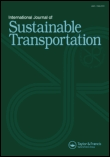
International Journal of Sustainable Transportation
Exploring Pathways to Sustainable TransportationInternational Journal of Sustainable Transportation, published by Taylor & Francis Inc, stands at the forefront of research in sustainable mobility, addressing critical challenges within the fields of engineering, environmental science, and urban planning. With ISSN 1556-8318 and E-ISSN 1556-8334, this journal is recognized for its exceptional quality, evidenced by its Q1 rankings across multiple categories including Automotive Engineering, Civil and Structural Engineering, Environmental Engineering, and Transportation, as well as a notable presence in Renewable Energy and Sustainability. Its impact is further amplified by impressive Scopus rankings, securing top positions in various fields, ensuring that it serves as a pivotal resource for researchers, practitioners, and policymakers dedicated to advancing sustainable transportation solutions. The journal actively disseminates cutting-edge research that informs sustainable practices worldwide, thus contributing to the development of greener transportation methods. As it continues its mission from 2007 to 2024, International Journal of Sustainable Transportation remains essential for anyone looking to explore innovative approaches to the transportation challenges of our time.

Frontiers in Future Transportation
Charting New Paths in Transportation StudiesFrontiers in Future Transportation, published by FRONTIERS MEDIA SA, is an influential Open Access journal that has been at the forefront of research since its inception in 2020. With an ISSN of N/A and E-ISSN 2673-5210, this journal provides a comprehensive platform for cutting-edge studies in the field of transportation, encompassing urban studies, automotive engineering, and innovative control systems. Ranking impressively in Scopus with notable percentiles—61st in Urban Studies, 51st in Automotive Engineering, and others—it underscores its significance within the scholarly community. The journal is committed to advancing the discourse surrounding sustainable and smart transportation solutions that address the challenges of future mobility. By offering unrestricted access to research, it invites contributions from researchers, professionals, and students alike, fostering collaboration and disseminating knowledge pivotal to transforming transportation systems globally. With its headquarters based in Lausanne, Switzerland, Frontiers in Future Transportation is poised to make substantial contributions to the evolving landscape of transport research through 2024 and beyond.

Transportation Safety and Environment
Elevating standards in transportation safety and environmental impact.Transportation Safety and Environment is an esteemed open-access journal published by Oxford University Press, dedicated to advancing the field of transportation safety and environmental sustainability. Since its inception in 2019, the journal has rapidly gained recognition with an impressive Q2 category ranking in Control and Systems Engineering, Engineering (miscellaneous), and Safety, Risk, Reliability and Quality as of 2023. With an E-ISSN of 2631-4428, it provides a platform for high-quality research that addresses critical safety challenges and environmental impact within the transportation sector, covering a wide array of topics from vehicle safety measures to ecological considerations in transportation infrastructure. The journal’s open-access model promotes widespread distribution and accessibility of research findings, enabling researchers, professionals, and students to engage with the latest advancements and contribute to future developments in the field. Located in the heart of the United Kingdom at Great Clarendon St, Oxford OX2 6DP, England, Transportation Safety and Environment stands at the forefront of fostering innovative solutions for safer and more sustainable transportation practices worldwide.
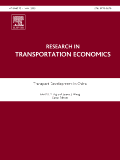
Research in Transportation Economics
Advancing Knowledge at the Intersection of Transport and EconomicsResearch in Transportation Economics, published by Elsevier Science Ltd, is a leading academic journal dedicated to the advancement of knowledge in the fields of transportation economics and policy. With an ISSN of 0739-8859 and an E-ISSN of 1875-7979, this journal serves as a critical platform for researchers, scholars, and practitioners to contribute groundbreaking studies and analyses that influence both theoretical frameworks and practical applications. Recognized with a Q1 rank in the category of Economics, Econometrics, and Finance (miscellaneous) and a Q2 rank in Transportation for 2023, the journal stands out in its commitment to rigorous research, presenting insights that enhance our understanding of economic dynamics within the transportation sector. With a robust Scopus ranking positioned at #9 out of 242 in its primary category, achieving a remarkable 96th percentile rating, Research in Transportation Economics is integral for those looking to explore the intersection of economics and transport systems. The journal welcomes contributions on various themes ranging from transport policy analyses to the evaluation of economic impacts on transportation systems, thus playing a vital role in shaping future policies and practices in the industry. As the field continues to evolve, the journal's annual publications from 2004 to 2024 will provide ongoing opportunities for scholarly exchanges and innovations.
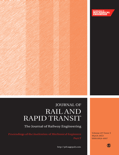
PROCEEDINGS OF THE INSTITUTION OF MECHANICAL ENGINEERS PART F-JOURNAL OF RAIL AND RAPID TRANSIT
Advancing the Future of Rail and Transit EngineeringPROCEEDINGS OF THE INSTITUTION OF MECHANICAL ENGINEERS PART F - JOURNAL OF RAIL AND RAPID TRANSIT is a premier academic journal published by SAGE Publications Ltd, focusing on the latest advancements in rail transportation and rapid transit systems. With an ISSN of 0954-4097 and E-ISSN of 2041-3017, this journal has garnered significant attention in the field, achieving a Q2 category ranking in Mechanical Engineering and securing a Scopus rank of #192 out of 672, placing it in the 71st percentile. Covering converged years from 1989 to 2024, it provides a platform for innovative research and discussions that address the complexities and evolving technologies within the rail industry. Its publication draws contributions from esteemed researchers, professionals, and students alike, fostering a crucial dialogue on sustainability, efficiency, and advancements in transit infrastructure. While the journal is not open access, it remains a vital resource for those committed to pushing the boundaries of mechanical engineering and rail systems development.

International Journal of Intelligent Transportation Systems Research
Fostering Knowledge for Safer, Efficient TravelInternational Journal of Intelligent Transportation Systems Research, published by Springer, stands as a premier platform for disseminating cutting-edge research in intelligent transportation systems (ITS). Established in 2010, this journal has made significant strides in addressing the complexities and innovations within the realm of transportation engineering, automotive technology, control systems, and information systems, reflected in its impressive categorization across diverse engineering and applied mathematics disciplines with notable rankings in Q2 and Q3 quartiles. With a steadfast commitment to advancing knowledge and fostering discussions that bridge academia and industry, the journal welcomes high-quality research articles, reviews, and case studies that explore emerging trends, technologies, and methodologies shaping the transport sector. Researchers, professionals, and students alike will find a wealth of insights aimed at optimizing operational efficiencies and enhancing safety and sustainability in transportation networks. As of 2023, the journal continues to thrive, seeking to compile contributions that align with its mission of improving transportation systems globally.
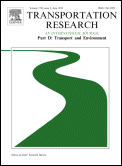
TRANSPORTATION RESEARCH PART D-TRANSPORT AND ENVIRONMENT
Exploring the intersection of mobility and ecological responsibility.Transportation Research Part D: Transport and Environment is a premier academic journal published by Pergamon-Elsevier Science Ltd, dedicated to advancing knowledge in the fields of civil and structural engineering, environmental science, and transportation. With an impressive Impact Factor and ranked in the Q1 category for 2023 across multiple disciplines, this journal serves as a critical resource for researchers, professionals, and students interested in the intersections of transportation systems and environmental challenges. Spanning the years from 1996 to 2024, the journal features innovative studies that address pressing transportation and environmental issues, fostering interdisciplinary collaboration and insights. Although not an open-access journal, articles published in Transportation Research Part D are accessible through institutional databases, making significant contributions to academia and practice in the UK and globally. Scholars looking to stay at the forefront of research related to sustainable transport solutions and their implications for the environment will find this journal indispensable.

Vehicles is a pioneering open access journal published by MDPI since 2019, dedicated to advancing knowledge in the fields of Automotive Engineering and Electrical and Electronic Engineering. Based in Switzerland, the journal provides a valuable platform for researchers, professionals, and students to disseminate high-quality, peer-reviewed research across essential areas of vehicle technology and innovation. With an impressive Q2 ranking in both Automotive Engineering and Electrical and Electronic Engineering as of 2023, and a notable placement in the Scopus rankings (Rank #37/125 and #320/797, respectively), Vehicles plays a critical role in fostering collaboration and knowledge exchange within these fast-evolving disciplines. Through its commitment to Open Access, Vehicles ensures that cutting-edge research is accessible to a global audience, thereby contributing significantly to the collective understanding and development of sustainable transportation solutions. Situated at the crossroads of engineering innovation and practical application, Vehicles invites contributions that explore contemporary challenges and promote transformative advancements in the automotive sector.
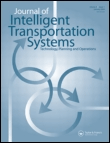
Journal of Intelligent Transportation Systems
Advancing the Future of Transportation TechnologyThe Journal of Intelligent Transportation Systems is a premier peer-reviewed journal published by Taylor & Francis Inc, focusing on cutting-edge research in the fields of transportation systems and intelligent technologies. With an ISSN of 1547-2450 and an E-ISSN of 1547-2442, this journal stands out with its impressive impact, consistently ranking in the Q1 Quartile across multiple categories such as Aerospace Engineering, Applied Mathematics, and Automotive Engineering, among others. As of 2023, it holds distinguished Scopus rankings, including a remarkable #11 position in Aerospace Engineering, showcasing its significance in shaping contemporary research in intelligent transportation. Targeted at researchers, professionals, and students alike, the journal provides a forum for the dissemination of innovative ideas and technologies that enhance transportation systems’ efficiency, safety, and sustainability. The Journal of Intelligent Transportation Systems has been operating since 2004 and continues to play a vital role in advancing knowledge within its respective areas of study within the United Kingdom and globally.